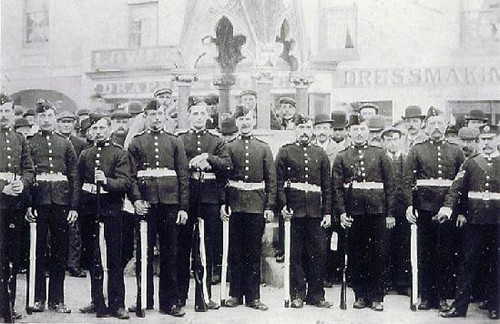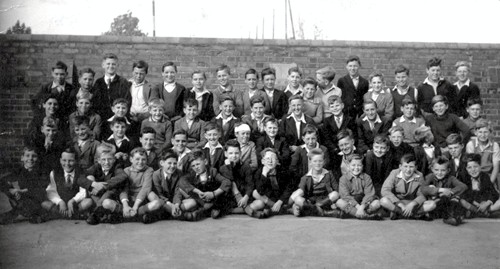THE MILITIA: Until the first
regiments of the regular army were formed in the mid-17th century the only
way that an army could be raised in times of trouble was through the
militia when able bodied men could be conscripted. Those from towns such
as Bourne were selected either by the parish constables and later by
ballot, serving three or five years on the defence of the realm.
There were exemptions for married men with several children or those who
did not fit the physical requirements, but it was an unpopular system and
from 1831 recruits were confined to volunteers only with militia units
later being attached to the local county regiments, such as the
Lincolnshire Regiment. The militia finally petered out around 1907 being
converted into what is now the Territorial Army.
The English Civil War: The earliest reference we have to troops in
Bourne is during the civil war of 1642-49, the armed conflict between
Royalist and Parliamentary forces arising from the constitutional,
economic and religious differences between Charles I and the Long
Parliament. Bourne was of little importance in the conflict but the parish
registers do record an entry under Burials showing that on 14th December
1643, Elizabeth Gee was interred after being "shot by ye soldiers". It is
not clear whether these were Royalist or Parliamentary forces but at this
stage in the war, the districts around Spalding and Stamford, which might
well have included Bourne, were in sympathy with the Parliamentary cause.
The threat from Napoleon: There was also some activity in the town
when Napoleon was planning to invade England and the recruitment of
soldiers became a priority to back up the regular army. By 1794, several
units had been formed and began training with firelocks, an early type of
musket in which the priming was lit by sparks, although others equipped
themselves with farm tools and other implements such as pitchforks while
those who had their own horses joined a troop cavalry. The invasion never
came and by 1816, the volunteer units had been disbanded.
The Crimean War: The South Lincolnshire Militia visited Bourne
during the Crimean War from 1854-56 with fife and drum playing to attract
recruits and there were many volunteers. But the town's main effort was
directed towards raising money for a national patriotic fund to help
relatives of those killed and to provide material aid for the troops and a
consignment of linen and bandages weighing 2 cwt. was collected and sent
off to London for onward shipment to the war zone. The end of the war also
brought organised peace celebrations in the market place when the whole
town joined in a day of eating, drinking, fireworks, sports and
merrymaking.

The Boer War: Volunteers from
Bourne were among the first to enlist for the Boer War of 1899-1902, the
second of the South African Wars waged between the British and the Dutch
settlers. Many came from the town's own reserve unit, H Company of the
Second Volunteer Battalion, the Lincolnshire Regiment, which was based at
the Drill Hall in North Street. They were given a hearty send off with a
dinner at the Nag's Head and a march to the station accompanied by the
town band, the streets decorated with flags and lined with cheering
crowds.
The war ended in May 1902 and when the news reached Bourne there were
demonstrations around the town. Bonfires were lit in the Market Place and
South Street and blazing tar barrels rolled down the road. The police were
called out to maintain order and 29 people were arrested for various
offences including assault and throwing missiles but in view of public
opinion, the cases were either dismissed or the accused given light
sentences.
Bourne had provided 28 active service soldiers for the campaign and 22
arrived home safely the following August when they were given a
celebration dinner at the Corn Exchange with music and singing and each
was honoured with the presentation of an inscribed silver tobacco box.
The Great War: The jingoism which existed during the Boer War was
still evident when the First World War broke out in 1914, a conflict
between the Central European Powers of Germany, Austria-Hungary and their
allies and the Triple Entente of Britain and the British Empire, France
and Russia and their allies, later to include the United States of America
which entered the conflict in 1917. It was fought on the eastern and
western fronts, in the Middle East, in Africa and at sea and before it
ended in 1918, an estimated ten million lives were lost and twice that
number were wounded.

At first the army still depended on
volunteers and regular recruiting meetings were held around Bourne where
passionate speeches were made urging young men to rally to the cause.
Among the first to enlist were fifteen recruits who left Bourne to join
the Lincolnshire Regiment on Monday 31st August 1914 and they were
escorted to the railway station by the town's brass band with a large
number of residents following behind to give them a hearty send-off. In
the ensuing months, more lads volunteered but in 1917 army service became
compulsory for all young men with the introduction of conscription. It is
not known how many men from Bourne served during the Great War but at
least 97 lost their lives and their names are inscribed on the War
Memorial in South Street although it is thought that the figure was nearer
140 and that at least 40 names are therefore missing.
The fighting ceased at 11 am on Armistice Day, Monday 11th November 1918,
and within weeks, the boys started coming home and were honoured during
the official peace celebrations that were held in Bourne the following
year, on Saturday 19th July 1919. It was a lively occasion with a parade
though town headed by discharged and disabled soldiers, tea at the Abbey
Lawn for 1,000 children, sports and fireworks, although later in the
evening there were several incidents of unruly behaviour and again the
rolling of lighted tar barrels down the street which had marked the end of
the Boer War sixteen years before. The disturbances continued after
midnight and although there was no serious damage, the brigade remained on
duty until three o'clock the following morning.
The Second World War: Despite the promise by politicians that
Armistice Day would mark the end of the war to end all wars, another major
conflict broke out in 1939 but this time it was a global conflict which
involved most of the world's great powers, eventually forming two opposing
military alliances, the Allies lead by Britain and the Axis with Germany
at the centre.
It lasted until 1945, a long period of austerity, food rationing and fear
of the unexpected because enemy bombers could be overhead at any moment,
yet these years brought a greater involvement of the civilian population
on what came to be known as the Home Front. In Bourne, the people were
encouraged to save their money to help buy arms and munitions and even
raised enough to adopt a minesweeper, HMS Beryl, which eventually saw
distinguished service in the siege of Malta.
Home owners were persuaded to dig for victory by cultivating their gardens
and every available plot to grow more vegetables while everyone seemed to
be "doing their bit", a popular wartime phrase, by joining one of the
defence organisations such as the Home Guard or the Women's Land Army or
simply collecting waste paper or participating in one of the many economy
drives underway to help the war effort.

The Home Guard was
particularly successful, an army organisation devoted to the defence of
Britain later popularised by the television programme Dad's Army, but it
had a serious role to play and attracted many men who were less able for
active service or had important occupations and by the war’s end, a total
force of 1,600 had been raised in the Bourne area.
For the first time the effects of the war were actually felt in this town
when a German bomber crashed on the Butcher's Arms in Eastgate in 1941,
demolishing the building and killing seven people inside. There were other
minor bombing incidents but the town escaped largely unscathed yet still
made a major contribution to the war effort.
One of the great unselfish acts in our history was the reception and
housing of evacuees from Hull, the east coast port that attracted enemy
bombers, and during this time the people of Bourne opened their homes to
900 children. As the months went by, they arrived by train, each carrying
a case containing their clothes and a few precious possessions, an
identification label attached to their coats, many frightened and away
from home for the first time, but they were received by couples, many with
children of their own, who were prepared to care for them until the war
was over. The link between Hull and Bourne that was forged in those days
is still remembered and some of the evacuees even stayed on, married and
raised families.

The town also played host to a very different party of visitors who
started arriving in December 1943. The entire First Battalion of the
Parachute Regiment consisting of 550 officers and men were eventually
billeted in Bourne in readiness for the Battle of Arnhem which took place
in September 1944. During the nine months they were here, the men stayed
in a variety of accommodation, in halls
and homes, disused workshops and tents at Grimsthorpe Park, training for
this major assault but also taking an active part in the life of the
community and when they finally left, it appeared that the town was
suddenly deserted.
The battle was unsuccessful and 459 of the men stationed in Bourne were
killed, wounded, captured or reported missing. Some of those who survived,
returned and married the girls they had met during their stay and their
families live here today.
Once again, it is not known how many people from Bourne served in the war
but 32 are named on the War Memorial. It should also be remembered that
few families had not been touched in some way and when peace was declared
in 1945 there was a spontaneous outbreak of rejoicing with parades and
street parties and an optimism that life in future would be different.

The War Memorial: During the years following the Great War of
1914-18, Remembrance Day was observed by a lone bugler who sounded the
last post from the market place, now the town centre. He was veteran
soldier Richard Pattison (1879-1959), bandmaster of the last Bourne Town
Band, but in 1956, the present war memorial was built in South Street and
this has been the central point for the ceremony ever since.
The first war memorial in Bourne was the extension to the old Butterfield
Hospital in North Road, officially opened in 1921, and the first roll of
honour was inscribed on a wooden plaque which can still be found on the
west wall inside the Abbey Church.
The design of the new stone memorial was based on the cenotaph in
Whitehall, London, and is inscribed with the names of 97 local men who
lost their lives in the war together with 32 men who did not return from
the conflict of 1939-45 and a further three who died on active service
before the century ended.
The last name of the last soldier who died in the Great War to be added is
that of George Coverley. He had been overlooked when the memorial was
erected but after an approach by his relatives and the Royal British
Legion, his name was added in 1985. The names of several other soldiers
who died in action are also remembered with plaques in the Abbey Church
that were presented by family and friends.
 |


![]()